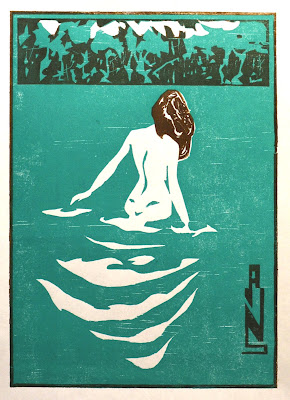This is a two color woodblock print made with oil based inks. Woodblock prints are "relief prints," in that the nonprintable areas are carved away, leaving a low relief of the image left level with the original uncarved surface.
The inspiration for this image is Ichijo Narumi's postcard print designed in 1906. Narumi's print is a lithograph, not a woodcut. But the simplicity of the design and imaginative use of the limited palette is a model for any printmaker doing their first two color print.
Two color prints are made using two printing plates. I carved both into one block of pine, each registered at the top and right sides so that I could simply slip the paper into the pre-carved grooves and know that the second printing would line up with the first. The green block is printed first, the brown second. Because the brown ink is transparent, where it overlaps the green ink, it produces the darker color of the forest and signature, making this technically a 3 color print.
I proofed the the block in different forms to gauge its appearance, leaving me with distinct "Artist Proofs." These allow the printer to see what work is left to be done. In this case I still needed to carve lines into the hair.
I produced 9 roughly identical prints using these colors. Future editions will use alternate colors. These first 9 are $29.50 a piece. Please message me to purchase. Or consider becoming a "Print Subscriber" through my Patreon page and receive a new print every month sent to your door. Patreon Page





Comments
Post a Comment